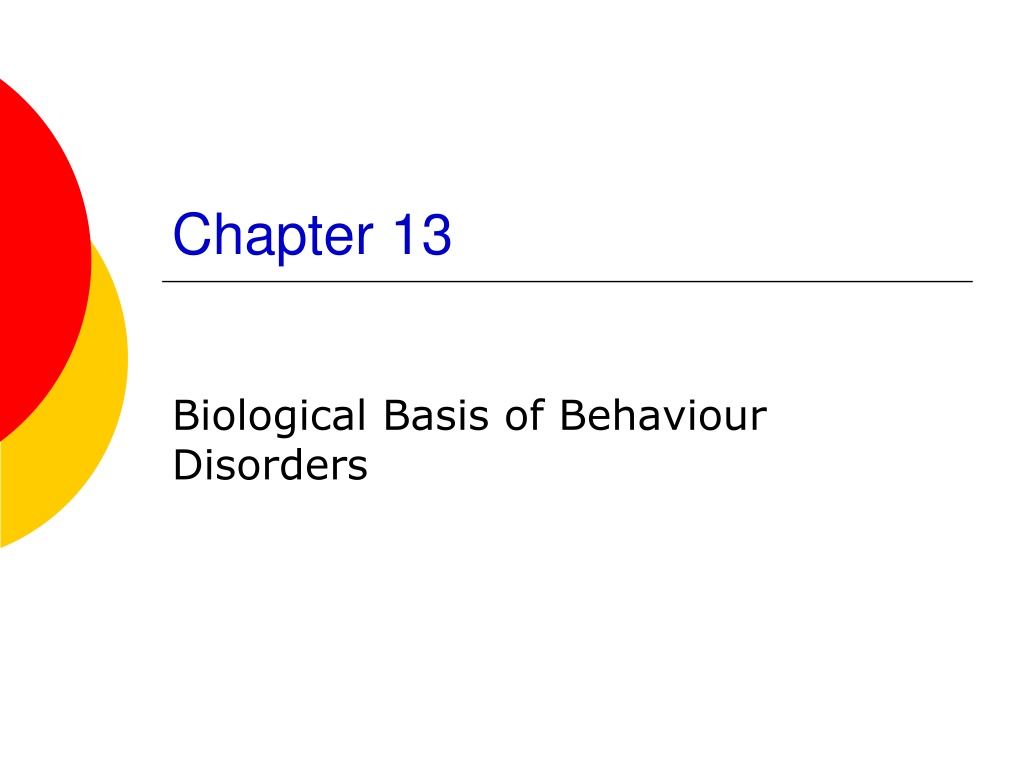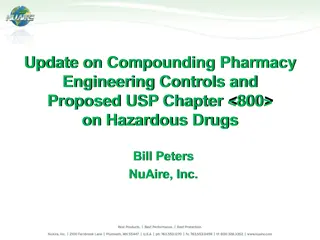
Understanding Affective Disorders: DSM-IV Dimensions & Characteristics
Explore the biological basis of behavior disorders, focusing on affective disorders as defined by the DSM-IV. Learn about the assessment dimensions, clinical syndromes, developmental and personality disorders, general medical conditions, psychosocial stressors, and levels of functioning. Dive into the characteristics of major depression and dysthymia, understanding the persistence and impact of these affective disorders on individuals. Gain insights into the assessment criteria and classifications within the DSM-IV framework.
Download Presentation

Please find below an Image/Link to download the presentation.
The content on the website is provided AS IS for your information and personal use only. It may not be sold, licensed, or shared on other websites without obtaining consent from the author. Download presentation by click this link. If you encounter any issues during the download, it is possible that the publisher has removed the file from their server.
E N D
Presentation Transcript
Chapter 13 Biological Basis of Behaviour Disorders
Affect disorders Diagnostic and Statistical Manual of Mental Disorders (4th edn), known as the DSM-IV. It assesses five dimensions: Axis I: Clinical Syndromes Axis II: Developmental Disorders and Personality Disorders Axis III: General Medical Conditions Axis IV: Severity of Psychosocial Stressors Axis V: Global Assessment of Highest Level of Functioning
DSM-IV Axis I: Clinical Syndromes This is what we typically think of as the diagnosis (e.g. depression, schizophrenia, social phobia) Axis II: Developmental Disorders and Personality Disorders Developmental disorders include autism and mental retardation, disorders which are typically first evident in childhood Personality disorders are clinical syndromes. They include Paranoid, Antisocial, and Borderline Personality Disorders Axis III: General Medical Conditions Which play a role in the development, continuation or exacerbation of Axis I and II disorders
DSM-IV Axis IV: Severity of Psychosocial Stressors Events in an individual s life, such as the death of a loved one, starting a new job, college, unemployment, and even marriage, can impact the disorders listed in Axis I and II. These events are both listed and rated for this axis. Axis V: Global Assessment of Highest Level of Functioning Functioning both at the present time and the highest level within the previous year. This helps the clinician understand how the above four axes are affecting the person and what type of changes can be expected
Affective disorders Persistence of high levels of depression or mania Major depression Dysthymia Bipolar disorder
Characteristics of depression Depressed mood Diminished interest in activities Weight loss Insomnia or hypersomnia Agitation Psychomotor retardation Fatigue or loss of energy Feelings of worthlessness or guilt Diminished ability to think or concentrate Recurrent thoughts of death, suicidal ideation
Major depression Depressed mood of 2 or more weeks May last several weeks to 6 months 50% will experience another episode within 2 years Dysthymia Depression with less intense symptoms A kind of low-level chronic depression Less debilitating than major depression May be considered to be a personality trait rather than a recognized condition
Mania Elevated, expansive or irritable mood Inflated self-esteem or grandiosity Increased or pressured speech Decreased need for sleep Distractibility Increased activity or psychomotor agitation Flight of ideas or thoughts Excessive involvement in high-risk activities
Bipolar disorder & cyclothymia Bipolar disorder Fluctuating manic and depressive moods Around 1% of population has BD Cyclothymia Similar but less intense Symptoms present for at least 2 years (1 or more years in children and adolescents)
Causes of affective disorders Genetics Concordance rate in identical twins much higher than in fraternal twins Bipolar rate of 50-100% in MZ twins Depression 50% in MZ twins Estimated genetic contribution to be 5 times higher for bipolar than for depression Many genes implicated
Causes of affective disorders: neurochemistry Disrupted neurotransmitter systems in the locus coeruleus (noradrenaline) (Leonard, 1997) and 5HT systems (Arranz et al., 1994) Major depression lower serotonin & norepinephrine metabolite Low levels of a serotonin metabolite (5-HIAA) have been found in individuals with major depression and recently linked to a greater suicide risk (Mann et al., 1999) low levels of a noradrenaline metabolite (MHPG) have been found in the cerebral spinal fluid of major depressive individuals (Maas et al., 1974)
Neuroanatomy of depression Reduced grey matter in the prefrontal cortex (Haldane & Frangou, 2004) Reduction in the grey matter ventral to the beginning of the corpus callosum (Drevets, Ongur, & Price, 1998) Underlying pathology of limbic system (Soares & Mann, 1997) Temporal abnormalities Seasonal Affective Disorder (SAD) is one manifestation of problems linked with the suprachiasmatic nucleus (SCN) (Howland, 2009)
HPA system Hyperactivity of the adrenal gland, which is more associated with symptoms of major depression see Chapter 10 Dexamethasone suppression test, which tests for excessive amounts of cortisol in depressive individuals (Kalin et al., 1981)
A biochemical depression marker Hypercortisolism in many with major depressions Elevated corticotrophin releasing hormone hypothalamic dysfunction Results in elevated ACTH secretion from pituitary Then abnormally high cortisol secretion from adrenal cortex
Treatment of affective disorders The two main treatments are talking therapies, such as counselling, and antidepressant medicines Medication Tricyclic compounds and MAO inhibitors Tricyclic compounds increase norepinephrine (interfere with re-uptake) MAO inhibitors increase by preventing breakdown Selective serotonin re-uptake inhibitor (SSRI) Prozac & Zoloft Have more predictable effects and less side-effects Lithium reduces norepinephrine levels reduces mania Therapies include cognitive behavioural therapy (CBT) and psychodynamic psychotherapy (Peng et al., 2009)
Symptoms of schizophrenia Auditory hallucinations: Hearing thoughts spoken aloud Hearing voices referring to himself/herself, made in the third person Auditory hallucinations in the form of a commentary Thought withdrawal, insertion and interruption Thought broadcasting Somatic hallucinations Delusional perception Feelings or actions experienced as made or influenced by external agents
Course of schizophrenic disorder Three stages Prodromal phase social withdrawal Active phase acute symptoms Residual phase
The biochemistry of schizophrenia Dopamine is classified as a catecholamine neurotransmitter and is a precursor of adrenaline and noradrenaline Mesocortical dopamine system disturbed function Ventral tegmentum to frontal cortex
The biochemistry of schizophrenia Dopamine hypothesis of schizophrenia Excess or increased sensitivity to dopamine Amphetamine & cocaine increase dopamine activity and produce schizophrenic symptoms Chlorpromazine acts as dopamine antagonist Blocks postsynaptic receptor sites Shown to bind to D2 dopamine receptor sites
NMDA and glutamate hypothesis This theory suggests that the NMDA receptor is underactive or hypofunctioning Gives rise to the negative symptoms and cognitive impairment seen in schizophrenia (Javitt & Zukin, 1991) Psychosis-like effects of PCP and ketamine which are both NMDA receptor antagonists
Risk factors of schizophrenia Genetics Concordance rate much higher for identical than fraternal twins Gene neuregulin 1 are associated with schizophrenia in an Icelandic sample (Stefansson et al., 2002) Most data suggests that we only inherit a predisposition
Risk factors of schizophrenia Schizophrenics are more likely to have complications with pregnancy and childbirth, especially premature birth, low birth weight, and hypoxia (Clarke et al., 2006) Smoking cannabis is also been identified as a possible factor Two to four-fold increased risk of developing the disorder (Semple et al., 2005)
Brain damage and schizophrenia Enlarged cerebral ventricles (Copolov & Crook, 2000) Disrupted cellular organization in the cortex (Jones, 1995) Brain imaging has revealed neural tissue loss around the frontal and anterior lobes and in the hypothalamus (Bogerts et al., 1992) Lesions to the prefrontal negative symptoms (Wolkin et al., 1992)
Neurological disorders When a neurologic disorder is suspected, clinicians usually evaluate all of the body systems during the physical examination which focuses on the nervous system Includes evaluation of mental status, cranial nerves, motor and sensory nerves, reflexes, coordination, balance and walking
The neurological examination Divided into seven areas and performed in an planned, step-wise manner General appearance, including posture, motor activity and vital signs Mini mental status exam, including speech observation Cranial nerves, I through XII. Motor system, including muscle atrophy, tone and power Sensory system, including vibration, position, pin prick, temperature, light touch and higher sensory functions Reflexes, including deep tendon reflexes Coordination and gait
Dementia: Alzheimers disease 5% of the population over the age of 65 20% over the age of 85 Alzheimer s disease most common Clinical assessment of Alzheimer s disease over 80% accurate
Dementia Other dementia - Huntington s disease - Creutzfeldt-Jacob disease - Lewy Body (varied up and down) - Vascular (stable time then relapse) Other causes and mimics of dementia - Depression - Delirium
Symptoms of dementia Vary in severity and order of appearance, based on type of dementia All dimensions involve - impairment of memory - thinking - reasoning - language - personality changes
The three As of dementia Aphasia language impairment Apraxia motor impairment Agnosia loss of ability to recognize objects
Stages of Alzheimers Stage 1 no impairment Stage 2 mild forgetfulness Stage 3 mild cognitive decline; earliest clear-cut deficits Stage 4 moderate cognitive decline; clear-cut deficit in careful clinical interview Stage 5 moderately severe cognitive decline; patient needs assistance with daily tasks Stage 6 severe cognitive decline; may occasionally forget the name of the spouse upon whom they are entirely dependent for survival Stage 7 very severe cognitive decline; severe loss of motor control, verbal speech lost
Classification of Alzheimers disease Sporadic occurs later in life and appears to be related to the apoE gene found on chromosome 19 Familial Alzheimer s disease (FAD) or Early Onset Familial Alzheimer s disease (EOFAD) Autosomal dominant and appears to involve the prensenilin and APP genes
Neurotransmitters and the ACh hypothesis Alzheimer s disease has shown an association with deterioration in the following neurotransmitter systems: acetylcholine (ACh) noradrenaline serotonin Degereration of neurons of nucleus basalis of Meynert acetylcholine
Beta amyloid hypothesis Amyloid are plaque-like buildups of proteins Cause holes in the brain Cause destruction of neuron process
What causes amyloids? Abnormal peptide fragment called beta amyloid ( A) This A protein is part of the amyloid precursor protein (APP), normally found in brains Protease enzymes cleave A fragments These fragments form plaques
Amyloid preprotein (APP) gene A 39-43 A.A. fragment which forms the core of the amyloid plaques Located on chromosome 21 APP mutations may result in: - overproduction of A protein - changed the configuration of APP This facilitates abnormal cleavage, resulting in increased formation and deposition of A The association between Downs Syndrome and AD
Beta amyloid hypothesis Amyloid precursor protein (APP) is the precursor to amyloid plaque 1. APP sticks through the neuron membrane 2. Enzymes cut the APP into fragments of protein, including beta amyloid Beta amyloid fragments In AD, many of these clumps form, disrupting the work of neurons. This affects the hippocampus and other areas of the cerebral cortex
The tau hypothesis Tau protein is essential for the growth of neurons and stabilization of microtubules Tau is a microtubule associate protein (MAP) that is made up of a group of six proteins in mammals Forms neurofibrillary tangles Distribution and abnormal phosphorylation of tau are one key piece of the pathology of AD
Presenilin 1 gene Early-onset AD Located on chromosome 14 Function in healthy neurons: - codes for a transmembrane protein involved with protein transport within cells or acts as a receptor or channel protein It alters APP by forming longer A protein
Presenilin 2 gene Early-onset AD Located on Chromosome 1 Function in normal healthy neurons: - Protein transport within cells and/or a receptor or channel protein There is a single mutation in PS 2 leading to AD The A protein is increased in plasma of people with the PS 2 mutation
Apolipoproteine E gene Late-onset AD Located on chromosome 19 There are 3 isoforms (alleles) for this gene: - E2 - E3 - E4 The difference in each isoform is associated with a change in one of two positions on the peptide There is an increased genetic risk factor associated with the E4 allele
ApoE gene Its product may perform many functions in the brain It is found in the extracellular space bound or free Its location suggest many functions, not all relevant to AD ApoE may have a role in neuronal metabolism and neuronal degeneration and regeneration in the CNS ApoE3 stabilizes microtubules by binding to tau, thus preventing abnormal phosphorylation and protecting cell integrity ApoE4 does not do this
Other risk factors Medical history - History of head trauma - Depression Lifestyle factors - Alcohol consumption Environmental exposures - Aluminum - Lead
Parkinsons disease (PD) By the time of diagnosis at least 60% of dopamine neurons in the substantia nigra have already been lost 60-80 year olds Both sexes equally affected One in 1,000 60,000-80,000 affected in the UK Less in Africa and China No in-vivo biological markers Clinical diagnosis 75% accurate
Symptoms of PD Resting tremor Cog-wheeling Festinating gait Rigidity Bradykinesia Dementia Depression
Assessment scales The original UPDRS is composed of 4 sections, including: 1. Mentation, behaviour and mood 2. Activities of daily living 3. Real-time assessment of motor features 4. Complications of therapy
Causes of PD Genetic PARK1 and PARK4 genes leucine-rich repeat kinase 2 (LRRK2) gene (PARK8) is also an autosomal dominant gene Parkin gene (PARK2) is autosomal recessive and the most common mutation related to young-onset PD (Lucking et al., 2000) Environmental Infections Oxidative stress
Neural structures involved in PD Nigrostriatal dopamine pathway Transmits dopamine from the substantia nigra (SN) to the neostriatum basal ganglia motor loop Loss of pigment in substantia nigra and locus coeruleus (nucleus accumbens circuit) SN decrease in pigmented neurons (20% remaining) shrinkage of existing neurons Lewy bodies Neurofibrillary tangles in hippocampous, cerebral cortex, globus pallidus and hypothalamus
Pathology of PD Loss of pigment in substantia nigra and locus coeruleus (nucleus accumbens circuit) SN decrease in pigmented neurons (20% remaining) shrinkage of existing neurons Lewy bodies Neurofibrillary tangles in hippocampous, cerebral cortex, globus pallidus and hypothalamus
PD circuity Axon loss in SN inhibitory at D2 To globus pallidus Increases in excitation = increased inhibition to thalamus = decreased excitation to cortex
Management of PD Balance dopamine and acetylcholine Anticholinergics treat tremor and salivation L-dopa Transplantation Ventromedial pallidotomy Thalamic stimulation
















